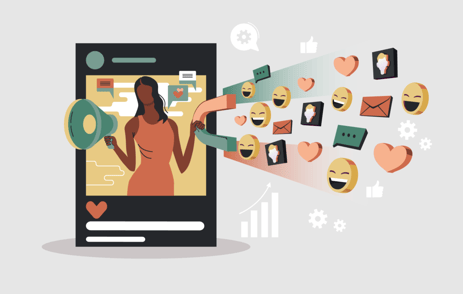The first time I used Clubhouse felt like the first time I’ve ever used any social media app: I was a little confused, a little intrigued and definitely felt like I’d just unlocked something special.
If you haven’t heard of Clubhouse yet, you’re not alone. The vast majority of users are just now getting to the app, which is currently accessible via invites and only for iPhone users. But even with those restrictions, it’s growing fast.
Since the app’s debut in May, it has welcomed more than 8 million users worldwide, and was valued at $100 million after buy-ins from Andreessen Horowitz and other firms.
So, what’s the big deal? Clubhouse is definitely different from any other social media app out there, so any leader responsible for growing their audience needs to make sure they’re getting the details on the latest app.
What makes it different?
We know Instagram is for photos, Twitter is for headlines and quick updates, TikTok is for dancing tweens and cleaning tips, and Facebook is for baby photos and angry political battles between extended family (kidding! … kind of). So, what makes Clubhouse different? The app is strictly audio-based, and chat rooms (or “Clubs”) are divided into categories like entrepreneurship, entertainment, faith and wellness. The content is intended to be one-time entertainment, so unlike a podcast, the conversations aren’t recorded, and anyone can start one.
Users are also encouraged to represent themselves honestly and use their real names, but verification is limited to phone number checks and there are no blue check marks.
Who’s it for?
Anyone, really, but Clubhouse was adopted early by people in tech and Black creators, which has made it especially popular among entrepreneurs and the Black community. Still, anyone can make a room, and anyone can join the public conversations. That doesn’t mean everyone gets heard, though: Only moderators can unmute users, so it’s not like a big garbled mess of conversation.
When you join, you can select who you’d like to follow and what topics you’re interested in, so you’ll start to receive notifications when related conversations go live.
Should you be on it?
If you’ve got any interest in hearing directly from high-level entrepreneurs, entertainers or creating conversations around important topics, there’s no reason not to join because how you use it is entirely up to you.
For me, I find it hard to listen to a conversation unless I’m totally invested, so it doesn’t make sense for me to listen to Clubhouse when I’m working, but it could be something I listen to on a drive or doing some chores around the house.
How do you get started?
First, you need an iPhone, and second, you need an invite. (I’ve got a few, so email me at Chelsea@SidecarGlobal.com if you need one!) Then, just download and follow the prompts to get started.
What’s the use case for leaders?
Hearing directly from leaders in other organizations can be incredibly eye-opening, and it’s possible to learn from others as they tackle tough questions in conversation. Plus, if you raise a hand and get invited to speak, it could be a great way to ask for advice, share your own thought leadership or get connected to someone you may never have the chance to meet in person.
What’s the use case for associations?
The app is still new, but Clubhouse offers an excellent place to build conversation around specific topics. That’s why it’s great for association leaders: It’s easy to develop your own reputation as an expert on a certain topic, and it’s easy to get connected with people who may have similar struggles or goals. Plus, it’s new, so the opportunity to make space for the things that matter to you is wide open.
Tags:
Technology
February 24, 2021

